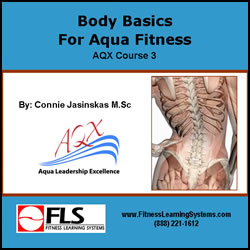Course Description:
Body Basics for Aqua Fitness is designed to give you fundamental knowledge about functional anatomy, kinesiology, and physiology related to vertical aquatic training (aqua fitness). This course (AQX Course 3) explains muscle roles and priorities, key training principles, as well as physiology of vertical immersion. Over 71 videos and several interactive and printable activities. Whether you are working with sports teams, post-rehabilitation groups, aquatic personal training, or seniors' group aqua fitness, Body Basics for Aqua Fitness is fundamental to your success.
Education Level: Beginner
Prerequisites: None
Successful completion of the quiz is necessary to receive Continuing Education Credit.
Approved for:
| 3.0 | American College of Sports Medicine (ACSM) |
| 0.3 | American Kinesiotherapy Association (COPS-KT) |
| 0.3 | International Accreditors for Continuing Education and Training (IACET) |
| 0.3 | National Association for Fitness Certification (NAFC) |
| 1.5 | National Council on Strength & Fitness (NCSF) |
| 0.5 | National Federation of Professional Trainers (NFPT) |
| 3.0 | National Strength Professionals Association (NSPA) |
| 3.0 | YMCA |
